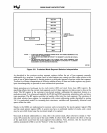
80286
BASE
ARCHITECTURE
Ordinal:
An unsigned binary numeric value contained
in
an 8-bit byte or 16-bit
word.
Pointer:
A 32-bit address quantity composed of a segment selector component and an offset component.
Each component
is
a 16-bit word.
String:
A contiguous sequence of bytes
or
words. A string may contain from 1 byte to 64K bytes.
ASCII:
A byte representation of alphanumeric and control characters using the. ASCII standard of
character representation.
BCD:
A byte (unpacked) representation of the decimal digits
(0-9).
Packed BCD:
A byte (packed) representation of
two
decimal digits (0-9). One digit
is
stored in each nibble of the
byte.
Floating Point:
A signed
32-,
64-, or 80-bit real number representation. (Floating operands are supported using the
80287 Numeric Processor Configuration.)
Figure
2-3
graphically represents the data types supported by the 80286. 80286 arithmetic operations
may be performed
on
five
types of numbers: unsigned binary, signed binary (integers), unsigned pflcked
decimal, unsigned unpacked decimal, and floating point. Binary numbers may be 8
or
16
bits long.
Decimal numbers are stored
in
bytes;
two
digits per byte for packed decimal, one digit per byte for
unpacked decimal. The processor always assumes that the operands specified
in
arithmetic instructions
contain data that represent valid numbers for the type of instruction being performed. Invalid
data
may produce unpredictable results.
Unsigned binary numbers may be either 8
or
16
bits long; all bits are considered
in
determining a
number's magnitude. The value range of an 8-bit unsigned binary number
is
0-255;
16
bits can repre-
sent values from
0 through 65,535. Addition, subtraction, multiplication and division operations are
available for unsigned binary numbers.
Signed binary numbers (integers) may be either 8 or
16
bits
long.
The high-order (leftmost) bit
is
interpreted
as
the number's sign: O=positive and 1 = negative. Negative numbers are represented
in
standard two's complement notation. Since the high-order bit
is
used for a sign, the range of an 8-bit
integer
is
-128
through +
127;
16-bit integers may range from -.32,768 through + 32,767. The value
zero has a positive sign.
2-4


















